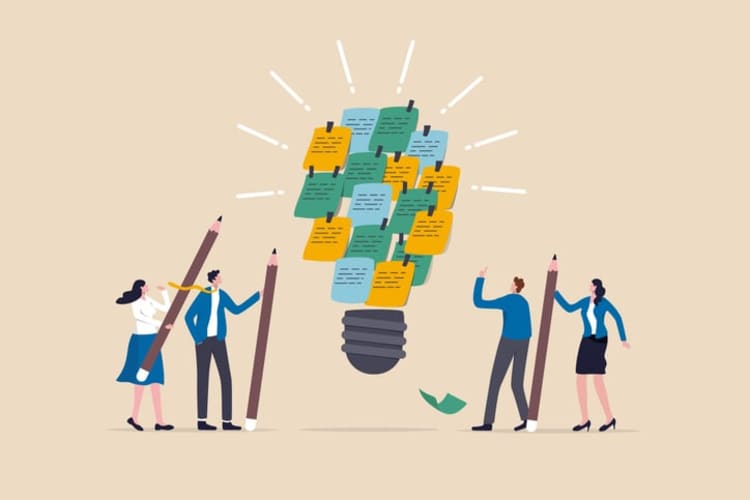In a world of infinite choices and complex situations, making the right decision can feel like an insurmountable challenge. Fear not, for decision-making models offer a structured approach to navigate the labyrinth of possibilities and guide you towards the best outcome. Buckle up as we explore the realm of decision-making models, uncover their secrets, and learn how to conquer biases in pursuit of clarity and confidence.
Key Takeaways
- This article examines five popular decision-making models and their applications, emphasizing that no single model is a universal solution.
- Overcoming Decision-Making Biases involves challenging one’s own beliefs, questioning recalled information, maintaining skepticism of success stories and gathering more data.
- Kumospace provides tools and resources to facilitate effective decision making with confidence in a supportive environment.
Demystifying decision-making models

The art of decision-making is critical to success in both personal and professional realms. Decision making processes, as well as decision-making models, provide structured approaches to guide individuals in making better choices, helping to simplify complex situations and improve outcomes. These models can be both structured and informal, depending on the situation at hand, and can range from logical, analytical approaches to intuition-driven ones.
Grasping the different models and their applications allows you to adapt your decision-making style to optimally suit the challenge at hand. Whether you’re a seasoned executive or a young professional, having a decision-making model in your arsenal can greatly improve your ability to tackle problems and find the best solution.
We will now delve into the essence of decision-making models, such as decision tree, and the reasons they should be incorporated into your toolbox.
What are decision-making models?
Picture decision-making models as roadmaps, guiding you through the twists and turns of complex problems by providing a structured approach based on the type of problem and available data. These models help you evaluate possible alternatives and make informed choices, ultimately leading to optimal decisions. From team leaders to individual contributors, decision-making models empower decision makers to navigate through a sea of information and find the best possible decision.
Different decision-making models cater to varying situations, from those with abundant data to those where factual information is scarce. Comprehending the characteristics and advantages of each model allows you to choose the most fitting approach for your specific challenge, facilitating confident and well-informed decisions for you and your team members.
Why use decision-making models?
Utilizing decision-making models can be a game changer in your decision-making process. They offer the potential to make more informed choices, thereby increasing confidence and achieving better outcomes in a variety of contexts. These models bring objectivity to the table, evaluating all data impartially and uniformly, eliminating prejudices and subjective judgments.
For experienced decision makers, the Intuitive Model enables informed decisions based on expertise and intuition. This model is most advantageous when dealing with areas where one has a great deal of expertise or experience. By identifying the right model for your situation, you can ensure that your decision-making style is tailored to the challenge at hand, ultimately leading to the best course of action.
Analyzing popular decision-making models

Having underscored the importance of decision-making models, we will now examine five popular models and their applications in various contexts:
- The Rational Model
- The Intuitive Model
- The Recognition Primed Model
- The Creative Model
- The Vroom-Yetton Model
Appreciating the intricacies of each model allows you to pick the most apt one for your unique situation, fostering the best possible decisions.
As we navigate the realm of decision-making models, bear in mind that no single model offers a universal solution. Each model has its strengths and weaknesses, and your choice should be guided by the specific context and requirements of your decision-making challenge.
The Rational Model: logic and analysis
The Rationality Decision Making Model, also known as the Rational Model, is a methodical approach to assess issues, identify criteria, and consider alternatives. This model involves a series of logical steps, including:
- Clarifying the goal
- Gathering information and identifying options
- Evaluating the options based on criteria
- Making a decision
- Implementing the decision
- Evaluating the final decision
The Rational Model works best when there is a plethora of options to be taken into account and a sufficient amount of time to evaluate them.
However, it is advisable to refrain from using the rational model when operating within stringent time limitations or lacking all the requisite information. In such cases, alternative models like the bounded rationality decision making may be more suitable, as they facilitate rapid decision-making without requiring extensive time or effort.
The Intuitive Model: trusting your gut
The Intuitive Decision Making Model, also known as the intuitive decision making approach, relies on gut feelings and subconscious knowledge, making it effective when dealing with areas where one has a great deal of expertise or experience. This model can be particularly useful for time-sensitive decisions, where conscious reasoning might not be feasible due to time constraints.
However, the Intuitive Model is less effective in unfamiliar situations, such as when beginning a new job role, where there is not sufficient experience to identify patterns quickly. In these cases, it’s important to recognize the limitations of intuition and consider other models that may be more suitable for the situation at hand.
The Recognition Primed Model: expertise and instinct
The Recognition Primed Model combines expertise and instinct to enable the rapid recognition of patterns and evaluation of solutions. This model is applicable when there is an abundance of contextual knowledge and a requirement to adapt to varying circumstances. Understanding how the recognition primed model works is particularly useful for high-pressure professions, where quick decision-making is essential.
However, the Recognition Primed Model should be avoided when:
- The decision-maker is not an expert
- The decision-maker is not familiar enough with the situation to anticipate potential outcomes
- The decision-maker is not operating within a limited timeframe
In such cases, alternative models like the Rational Model or the Creative Model may be more appropriate for finding possible solutions.
The Creative Model: innovation and imagination
The Creative Model focuses on devising original solutions through brainstorming, concept development, and execution. This model is advantageous in circumstances that necessitate imaginative thinking and the formation of novel solutions. It can be particularly useful in the initial stages of social media marketing, when organizations had to create original social media campaigns without a plan for success.
However, the creative decision making model can be time-consuming, necessitating extensive brainstorming and meetings. Its success is contingent upon the creativity and availability of the decision maker to conceive of novel concepts. In situations where time is of the essence, or where creativity is not the primary requirement, other decision-making models may be more suitable.
The Vroom-Yetton model: collaborative decision-making

The Vroom-Yetton Model facilitates collaborative decision-making by ascertaining the suitable level of input from team members depending on particular circumstances. This model evaluates key situational attributes and determines the degrees of employee involvement, spanning from:
- Autocratic decision-making by the leader
- Consultation with team members
- Joint decision-making with the leader
- Delegation of decision-making to team members
This model can be adapted to meet the requirements of the individual, making it suitable for personnel throughout different management levels. It is both flexible and user-friendly. However, it does not take into account personal factors for the decision-maker, the queries may not be accurate enough for certain circumstances, and it may not be as effective for larger groups. In such cases, alternative models that better suit the situation and the decision-maker’s characteristics should be considered.
Overcoming decision-making biases
Decision-making biases can negatively impact choices, leading to suboptimal decisions and potentially detrimental outcomes. By being aware of these biases and taking steps to overcome them, you can make better decisions and achieve the best outcomes. In the following section, we will investigate four prevalent decision-making biases:
We will also deliberate on strategies to mitigate these biases.
As we traverse the landscape of biases, it’s important to remember that everyone is susceptible to their sway. By acknowledging their existence and adopting strategies to counteract them, you can make more informed decisions and ultimately achieve greater success.
Confirmation Bias: challenging your beliefs
Confirmation Bias is the tendency to pay attention to evidence that confirms one’s beliefs while disregarding evidence that does not. This bias can lead to decisions being made without taking into account all the available evidence, ultimately resulting in suboptimal decisions. To counteract Confirmation Bias, it is recommended that individuals seek out people and information sources that challenge their opinions, even if they are already certain that “all the evidence” supports what they wish to do.
Embracing diverse opinions and interrogating your preconceived notions can lead to decisions grounded in a holistic understanding of the situation, increasing the likelihood of making the best possible choice.
Anchoring Bias: gathering more information

Anchoring Bias causes individuals to rely heavily on the first piece of information encountered when making decisions or judgments. This bias can lead to disproportionate weight being given to this initial information, regardless of its relevance or arbitrariness. To counteract Anchoring Bias, it is important to gather more data and take the time to analyze it, ensuring that your decisions are based on a comprehensive understanding of the situation.
By acknowledging the potential influence of Anchoring Bias and dedicating the necessary time and effort to gather and analyze additional information, you can make more informed decisions that are less susceptible to the influence of this bias.
Availability Heuristic: questioning recalled information
The Availability Heuristic refers to the phenomenon in which decisions are made based on how easily a particular concept or event can be recalled. This bias can lead to decisions being influenced by recent events or vivid memories, rather than a thorough analysis of all relevant information. To counter the Availability Heuristic, it is important to carefully examine your assumptions and procure additional data to ensure that your decisions are based on sound evidence.
By questioning the information that comes most easily to mind and seeking out additional data, you can make more informed decisions that are less influenced by the biases of memory and recollection.
Survivorship Bias: skepticism of success stories
Survivorship Bias involves making decisions based on successful examples while ignoring failures. This bias can lead to an overemphasis on success stories, potentially resulting in a distorted view of reality and suboptimal decisions. To overcome Survivorship Bias, it is important to maintain a healthy skepticism of success stories and consider the full range of outcomes, including failures.
By adopting a more critical stance and questioning the validity of success stories, you can make more balanced decisions that take into account both successful and unsuccessful examples, ultimately leading to better outcomes.
Enhancing decision-making with Kumospace
Kumospace, an immersive group video chat tool, offers a unique solution to support various decision-making models and streamline the decision-making process. By providing tools and resources that cater to different decision-making styles, Kumospace helps individuals make decisions with confidence and clarity in a variety of contexts.
We will now investigate the tools and resources available in Kumospace and discuss their role in boosting your decision-making skills, thereby equipping you to deftly handle complex situations with assurance.
Tools and resources in Kumospace
Kumospace provides a range of tools and resources to streamline the decision-making process, making it easier for individuals to navigate complex situations and make informed choices. These resources include a suite of features such as real-time collaboration, enabling teams to seamlessly engage in discussions and tackle multifaceted issues concurrently. The platform further enhances communication through its immersive video conferencing experience, allowing participants to pick up on critical non-verbal cues. Additionally, Kumospace facilitates efficient decision-making by providing intuitive document-sharing capabilities, fostering a collaborative environment that ensures well-informed choices.
Kumospace, with its array of tools and resources, allows users to delve into various decision-making models and refine their skills in a safe and supportive environment. This empowers individuals to make confident, well-informed decisions in various contexts, ultimately leading to better outcomes.
Summary
In this journey through the world of decision-making models, we have explored various frameworks and strategies to help you navigate the complex landscape of choices and make better decisions. By understanding the strengths and weaknesses of different models, overcoming biases, and leveraging tools like Kumospace, you can enhance your decision-making skills and achieve greater success in both your personal and professional life. Remember that the power to make wise choices lies within you; all you need are the right tools and guidance to unlock your full potential.
Frequently Asked Questions
The 5 main models of decision-making are the rational model, the intuitive model, the recognition-primed model, the creative model, and the Vroom-Yetton decision model. Each model has distinct characteristics that may be applied to different scenarios to make informed decisions.
The four types of decision making models discussed in this section are rational, bounded rationality, intuitive, and creative decision making. Each can be beneficial depending on the situation and the problem at hand.
The six basic elements of decision making models are: Problem Identification, Identification of Decision Criteria, Weighing the Decision Criteria, Developing Alternatives, Evaluating the Alternatives and Selecting the Best Alternative. These steps provide a structured and logical approach for making decisions.
Decision-making models provide a structured process to simplify complex situations, helping individuals make better choices and improve outcomes.
Decision-making biases can lead to suboptimal decisions by causing individuals to ignore contradicting information, rely too heavily on initial information, or make decisions based on successful examples while ignoring failures, thus negatively impacting choices.





